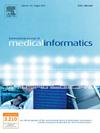基于多模态数据的精神科病房行为管理人工智能个性化实时风险预测
IF 3.7
2区 医学
Q2 COMPUTER SCIENCE, INFORMATION SYSTEMS
International Journal of Medical Informatics
Pub Date : 2025-03-12
DOI:10.1016/j.ijmedinf.2025.105870
引用次数: 0
摘要
背景自杀是一个重大的全球健康问题,每年约有70万人死亡(世卫组织)。在精神科病房,管理自杀、自残和攻击等有害行为对于确保患者和工作人员的安全至关重要。然而,由于患者与精神科医生的高比率和繁重的工作量,韩国的精神科病房面临着挑战。目前依赖人口统计数据的模型难以提供实时预测。本研究引入了时间融合变压器(TFT)模型,通过整合传感器、位置和临床数据来预测有害行为,以解决这些限制。TFT模型的高级特征,如变量选择网络和时间注意机制,使其特别适合于捕捉复杂的时间序列模式,并在精神病学设置中提供可解释的结果。方法使用可穿戴设备收集来自三家医院的145名患者的数据,跟踪心率、运动和位置。每小时汇总一次数据,进行预处理以处理缺失值,并进行标准化。利用TFT建立了一个二元分类模型,并对准确率、召回率、F1评分和AUC进行了评估。采用贝叶斯优化进行超参数调优,并进行5次交叉验证以确保可泛化性。结果TFT模型的准确率为95.1%,召回率为74.9%,F1得分为78.1,AUC为0.863,优于Multi-LSTM和Multi-GRU模型。变量选择网络有效地识别关键的预测因素,如每日熵和心率变异性,提高了可解释性。结合位置和生物特征数据提高了预测的准确性,并实现了实时风险评估。结论本研究首次应用TFT模型预测精神科病房患者的行为风险。该模型集成不同数据源、优先考虑关键变量和捕获时间依赖性的能力使其非常适合精神病学环境。虽然TFT模型表现良好,但由于数据集有限,召回仍然存在挑战。未来的研究将集中于扩展数据集,优化变量选择,并通过多模态公共数据模型(CDM)标准化数据,以进一步提高性能和临床实用性。本文章由计算机程序翻译,如有差异,请以英文原文为准。
AI-based personalized real-time risk prediction for behavioral management in psychiatric wards using multimodal data
Background
Suicide is a major global health issue, with approximately 700,000 deaths annually (WHO). In psychiatric wards, managing harmful behaviors such as suicide, self-harm, and aggression is essential to ensure patient and staff safety. However, psychiatric wards in South Korea face challenges due to high patient-to-psychiatrist ratios and heavy workloads. Current models relying on demographic data struggle to provide real-time predictions. This study introduces the Temporal Fusion Transformer (TFT) model to address these limitations by integrating sensor, location, and clinical data for predicting harmful behaviors. The TFT model’s advanced features, such as Variable Selection Networks and temporal attention mechanisms, make it particularly suitable for capturing complex time-series patterns and providing interpretable results in psychiatric settings.
Methods
Data from 145 patients across three hospitals were collected using wearable devices that tracked heart rate, movement, and location. The data were aggregated hourly, preprocessed to handle missing values, and standardized. A binary classification model using TFT was developed and evaluated with accuracy, recall, F1 score, and AUC. Bayesian optimization was employed for hyperparameter tuning, and 5-fold cross-validation was performed to ensure generalizability.
Results
The TFT model outperformed Multi-LSTM and Multi-GRU models, achieving 95.1% accuracy, 74.9% recall, an F1 score of 78.1, and an AUC of 0.863. The Variable Selection Network effectively identified key predictive factors, such as daily entropy and heart rate variability, improving interpretability. Incorporating location and biometric data enhanced prediction accuracy and enabled real-time risk assessments.
Conclusion
This study is the first to use the TFT model for predicting behavioral risks in psychiatric wards. The model’s ability to integrate diverse data sources, prioritize cirtical variables, and capture temporal dependencies make it highly suitable for psychiatric environments. While the TFT model performed well, challenges remain with recall due to the limited dataset. Future research will focus on expanding datasets, optimizing variable selection, and standardizing data through a multimodal Common Data Model (CDM) to further improve performance and clinical utility.
求助全文
通过发布文献求助,成功后即可免费获取论文全文。
去求助
来源期刊

International Journal of Medical Informatics
医学-计算机:信息系统
CiteScore
8.90
自引率
4.10%
发文量
217
审稿时长
42 days
期刊介绍:
International Journal of Medical Informatics provides an international medium for dissemination of original results and interpretative reviews concerning the field of medical informatics. The Journal emphasizes the evaluation of systems in healthcare settings.
The scope of journal covers:
Information systems, including national or international registration systems, hospital information systems, departmental and/or physician''s office systems, document handling systems, electronic medical record systems, standardization, systems integration etc.;
Computer-aided medical decision support systems using heuristic, algorithmic and/or statistical methods as exemplified in decision theory, protocol development, artificial intelligence, etc.
Educational computer based programs pertaining to medical informatics or medicine in general;
Organizational, economic, social, clinical impact, ethical and cost-benefit aspects of IT applications in health care.
 求助内容:
求助内容: 应助结果提醒方式:
应助结果提醒方式:


